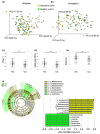Gut Microbiota Associated with Clinical Relapse in Patients with Quiescent Ulcerative Colitis
- PMID: 35630486
- PMCID: PMC9144486
- DOI: 10.3390/microorganisms10051044
Gut Microbiota Associated with Clinical Relapse in Patients with Quiescent Ulcerative Colitis
Abstract
The microbiota associated with relapse in patients with quiescent ulcerative colitis (qUC) remains unclear. Our objective was to analyze the fecal microbiota of Japanese patients with qUC and identify the relapse-associated microbiota. In this study, 59 patients with qUC and 59 healthy controls (HCs) were enrolled (UMIN 000019486), and their fecal microbiota was compared using 16S rRNA gene amplicon sequencing. We followed their clinical course up to 3.5 years and analyzed the relapse-associated microbiota. Potential functional changes in the fecal microbiota were evaluated using PICRUSt software and the Kyoto Encyclopedia of Genes and Genomes database. There were significant differences in fecal microbiota diversity between HC and qUC subjects, with 13 taxa characterizing each subject. Despite no significant difference in variation of microbiota in a single sample (α diversity) between patients in sustained remission and relapsed patients, the variation in microbial communities between samples (β diversity) was significantly different. Prevotella was more abundant in the sustained remission patients, whereas Faecalibacterium and Bifidobacterium were more abundant in the relapsed patients. We clustered the entire cohort into four clusters, and Kaplan-Meier analysis revealed the subsequent clinical course of each cluster was different. We identified 48 metabolic pathways associated with each cluster using linear discriminant analysis effect size. We confirmed the difference in microbiota between patients with qUC and HCs and identified three genera associated with relapse. We found that the clusters based on these genera had different subsequent clinical courses and activated different metabolic pathways.
Keywords: LEfSe; fecal microbiota; quiescent ulcerative colitis; ulcerative colitis relapse.
Conflict of interest statement
Tomohisa Takagi received lecture fees from Yanssen Pharmaceutical K.K., Mitsubishi Tanabe Pharma Co., and Mochida Pharmaceutical Co., Ltd. Yuji Naito received research grants from EA Pharma Co., Ltd. and research funding from Fujifilm Medical Co., Ltd. Yoshito Itoh received lecture fees from Merck Sharp and Dohme, Gilead Sciences Inc., and AbbVie Inc., and received research grants from Merck Sharp and Dohme, Bristol-Myers Squibb Company, Gilead Sciences Inc., AbbVie GK., Eisai Co., Ltd., Astellas Pharma Inc., and Takeda Pharmaceutical Company Limited., EA pharm CO., LTD., Bayer AG, Novo Nordisk Pharma Ltd., Nissan Chemical Industries, LTD., and received endowed courses from Nichinichi Pharmaceutical CO., LTD. The other authors have no conflicts of interest to declare.
Figures




References
-
- Takagi T., Naito Y., Inoue R., Kashiwagi S., Uchiyama K., Mizushima K., Tsuchiya S., Dohi O., Yoshida N., Kamada K., et al. Differences in Gut Microbiota Associated with Age, Sex, and Stool Consistency in Healthy Japanese Subjects. J. Gastroenterol. 2019;54:53–63. doi: 10.1007/s00535-018-1488-5. - DOI - PubMed
Grants and funding
LinkOut - more resources
Full Text Sources

